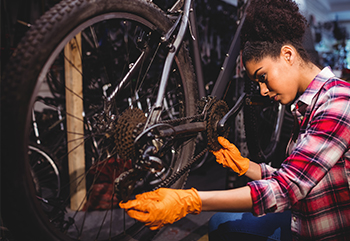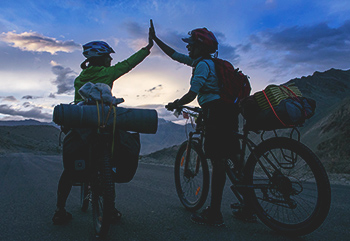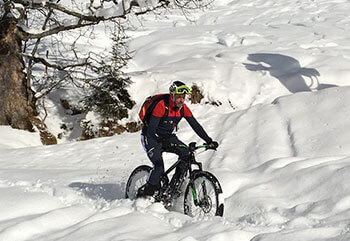Expert Tips For Cycling In The Rain

There's hardly anyone we know who does not look forward to the monsoons. It brings relief from the sweltering summer heat and has a romantic charm and aura around the sight and sound of falling raindrops. Most of our lives go on as usual, and we adjust to the light showers and heavy downpours. We dress and don footwear that complements the rainy weather. We also travel to hill stations and enjoy the beautiful sceneries and waterfalls during these months. While the monsoons do add to our lives, there's no reason to pause our cycling routines. We must, however, make a few adjustments, additions, and changes when we cycle. We have listed down a few ideas that make cycling fun and safe even when it rains. Follow them to have fantastic rain riding experiences
1) Put A Brake On Cycling

Okay, if this sounds counterintuitive to cycling in the rain, it's not. What we want you to do is avoid using your bicycle when it first starts to rain. The first rains bring up the oil and fuel on the road surface, making it slippery. Give it about 3-4 days of good rainfall for the surface oil to dissipate to avoid slipping and sliding while riding. During that time, we suggest you Rainproof Your Bicycle.
2) Rainproof Your Bicycle
The rain, the mud splashes, the wet roads can take a toll on your precious bicycle. What we recommend are a few precautions so that you can save the wear and tear associated with riding in the rains

i) Even as tacky as you feel they look, adding fenders and mudflaps will help save your bicycle and your back, face, and legs from road splash.
ii) Wet roads tend to get slippery for a road bicycle tyre. To counter this, reduce tyre pressure by 7-10 psi to give you a wider area coverage, ensure better grip, and increase the tractions on rained roads. Some cyclists choose to swap their road tyres with wider ones for the rainy months.
iii) Grease the bearings in the headset, brackets, wheels, and pedals to save them against damage from water, dirt, and grime, which are in abundance during the rainy season.
iv) It is highly recommended you lube your bicycle chain, derailleur, brake cables, and drive train so that you can pedal smoothly and enjoy frictionless shifting and braking. For the rainy season, use a heavier lube and apply it liberally than you would in normal conditions. Ensure that all the parts are dry, especially the chain so that the lube can penetrate the links well.
v) Now this one is a must-do each time you use your bike. Brush off grit and dirt from the chain, cassette, brake pads, rims, tyres, and drivetrain to safeguard your bicycle against deterioration and ensure pedaling efficiency. An easy way to get rid of the grit and grime that stick easily onto a wet bike is to spritz your bicycle after each ride using a sports top water bottle.
vi) Always wipe dry your bicycle after cleaning off the grit and dirt. And keep it dry when not in use. It would be best if you also took care to store your bicycle in a dry location and do not let it stand in water as well
That takes care of the bicycle. Now, let's find out what you should do to be rain-ready.
3) Rain Ready Yourself

i) Use a rainproof jacket while on your rides. Look out for one made with breathable material so that you don't feel all hot and sweaty. In addition to a rain jacket, you may find value in using rain pants to slip over your regular pants and shoes. You can carry them packed and only choose to use them when necessary.
ii) It is very uncomfortable to be in wet shoes. Use rainproof shoes, or you have the option of slipping on waterproof shoe covers over your regular footwear, making sure that they are slip-resistant and have a good grip, and won't slide off the pedals.
iii) Choose to wear a waterproof rimmed cap under your helmet that would shield the rain from hitting your face, especially your eyes directly. It's unsafe to ride with your eyes closed, even it's for a few seconds. Another rain accessory popular with riders is riding goggles. You can get ones that you can comfortably wear over spectacles if you wear a pair.
iv) Try and swap your riding gloves for waterproof ones. Make sure that they are not too thick and uncomfortable and won't allow you to maintain dexterity. If that's not an option, carry an extra pair of gloves along with you storing them in a plastic sealed cover.
Whenever you leave home, even while you cycle, your items need to stay safe and dry. Coming up are tips on how to do just that.
4) Rainproof Your Valuables

i) Swap your regular backpack with a waterproof one and use a rain cover to ensure the pockets and opening stay dry.
ii) All your valuables like your mobile phone, wallet, charger, keys, etc., should preferably be stored individually in waterproof pouches or ziplock bags.
iii) Carrying a dry set of clothing can be helpful in case you get drenched en route. Again they have to be packed in a waterproof case.
iv) All your kits, tools, etc. that are a part of your carry-on repair kit need to be protected from the rain so that they do not rust. Place the kits in plastic or waterproof pouches.
Read on to find out the safety tips that you would have to adapt to be a safe rider while pedaling in the rain.
5) Rain Riding Safety

i) When it rains, it gets cloudy and dull with the sun hidden away. The atmosphere gets dull and darker than normal. It would help if you were visible when you are riding on the roads. Ensure you have your lights on, both back and front.
ii) In Addition to the lights, wear a safety reflective vest or harness.
iii) Look out for the rainbow hue on the road ahead and avoid riding through it. It's the motor vehicle's oil and residue that makes the surface slick and slippery.
iv) Lookout and avoid riding on the painted white road markings, like traffic lane markings, zebra crossings, etc. Additionally, pay attention to wet leaves, maintenance hole covers, or drain covers. The rain makes them all extra smooth and slippery, especially for the slim road bicycle tyres,
v) Keep an eye out for debris that might have got washed onto the road because of a heavy downpour. As inviting as a puddle may seem, avoid riding through them. What may appear to be a harmless stretch of water can be a dangerously deep hole that can be a wheel smashing pothole.
vi) There are more chances of getting the bicycle tube punctured due to the wet road, which may have sharp debris. Make sure that you carry your puncture kit, extra tube included.
vii) The braking efficiency that you would be used to on non-rainy days may be different on wet roads. Water, grit, and grime will reduce the reaction of your brakes. You need to anticipate and brake earlier than you normally would and allow time to dry the braking track before their action is effective.
viii) Your riding style should be slightly more cautious when you are riding in the rain. Travel a bit slower than you normally would when going around corners and during descents. Don't be shy of altering your riding routes to ones with lesser traffic.

If you think these are a bit too many things, adjustments, and changes to consider to enjoy rain rides, a counter-argument would be that this would make you a better all-around cyclist. Cycling in wet or other challenging inclement weather, the more confidence you'll have in a wide range of conditions. Over time you'll build better bike-handling skills, develop more confidence and return home with an increased sense of accomplishment & achievement, and that is exhilarating in itself.
Do you have a tip or two that you'd like to share on riding in the rain? Wed love to hear from you and add to this comprehensive guide. Do write to us at
Related Blogs

Electric Bicycle
5 Maintenance Tips of Electric Bicycle | InfographicBicycle maintenance is most important for longevity. So, here are few tips that will help you to maintain your electric bicycle for a long time.

Mountain Bikes
8 Easy Tips for an MTB NewbieA few tips that you can use to make your MTB learning days an incredible experience

Mountain Bikes
Eight Tips To Ace Mountain BikingA mountain biking trip, while exciting can often be dangerous too. Read through these eight important and practical tips to ace the adventure.

